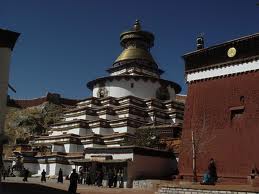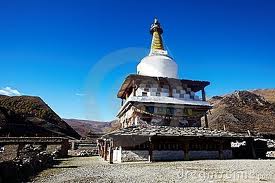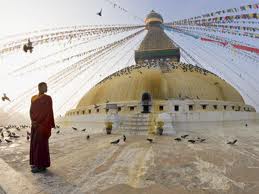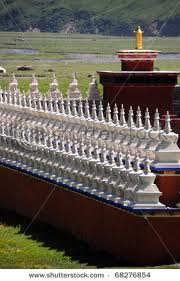Stupas
- Stupa represents the Buddha’s mind, each part of the Stupa shows the path to enlightenment
- building a Stupa is a powerful way to purify negative karma and to accumulate merit
- one way to real Enlightenment, liberate suffering beings
- future benefits, fortunate rebirths, worldly benefits such as being born into a rich family, having a beautiful body, a nice voice being attractive and bringing joy to others , having a long and happy life
- reach enlightenment-the goal of Buddhism
- destroying a Stupas-very negative, similar to killing
- massive negative karmic imprints
- leaves the mind in a state of paranoia after death, totally unfortunate rebirths
- a site is found, Pujas (prayers), earth deities addressed to remove obstacles for the successful building of the Stupa.
- workers must have the right motivation-every aspect of the stupa emanates the pure mind of Buddha
- to build as Stupa transmissions and ceremonies from a Buddhist teacher is necessary
- which kind of Stupa to be constructed in a certain area decided with the teacher assisting in construction
- type of setup related to the events taking place in the area
- 5 purified elements
- Stupa may represent the five purified elements
- the square base represents earth
- the hemispherical dome/vase represents water
- the conical spire represents fire
- the upper lotus parasol and the crescent moon represents air
- the sun and the dissolving point represent the element of space
- Stupas contain various objects-small offerings called Tsa and Tsas fill a major part of the treasury
- creation of types of Tsa-Tsas is a ceremony
- mantras written on paper, rolled into thin rolls and put into small clay Stupas
- jewelry and other precious objects also placed in the treasury
- more objects placed in the Stupa, the stronger the energy of the Stupa
- Tree of Life an important element
- wooden pole covered with gems and thousands of mantras, place in the center of the Stupa
- placed in a ceremony of initiation, participants hold colorful ribbons connected to the Tree of Life
- participants make their most positive and powerful wishes, stored in The tree of Life
- Stupa is charged up and will start to function
- Stupas originally a simple mound of clay to cover relics of the Buddha
- the importance of the Stupa changed from being a funerary monument to being an object of veneration
- Stupas at the eight places associated with the life of the Buddha continued to be of importance
- each Stupa sits on a square base called the Lions seat whose 4 sides relate to the 4 qualities of mind, relating to the attainment of enlightenment
- love, compassion, joy and equanimity
- base filled with jewels, precious texts and relics pertaining to the tradition of Stupa building
- on the Lions seat there are built 5 steps all representative of the progress of the mind towards enlightenment
- dome rests on a decorated base, referred to as the throne
- above the throne is a spire consisting of 13 rings, these rings symbolize the 13 stages of a Buddha’s advance towards Buddha hood
- the spire is topped by a small circular devise known as the drop, resting on a sun which rests on a lunar crescent.
- drop represents a jewel which is symbolic of enlightenment, the sun representing wisdom and the moon representing compassion.
|
|
|
Palkhor Monastry Stupa |
Daochen, West Sichuan, China |
Old Stupa |
|
|
|
Multiple Buddhas |
Dome of Buddha |
Multiple Buddhas |
|
|
|
Kumbum Stupa |
|
|
|








